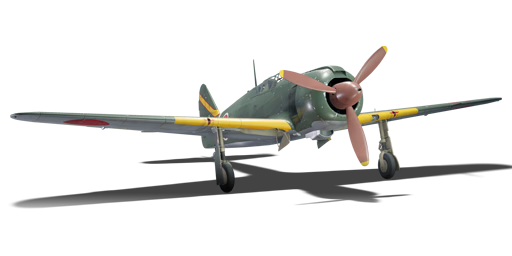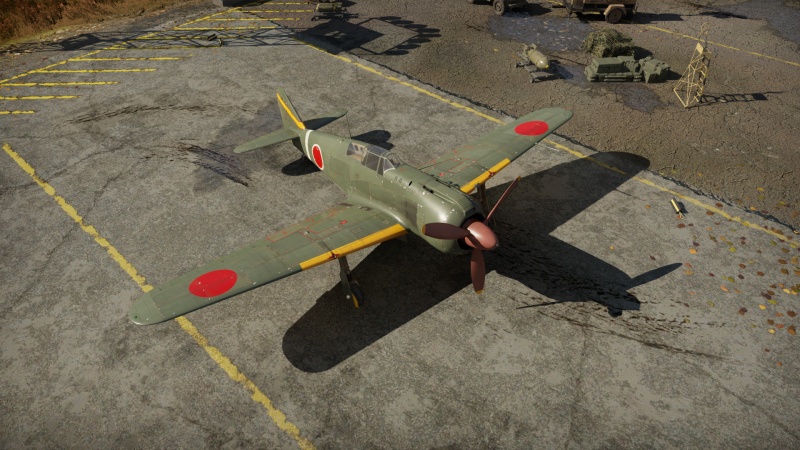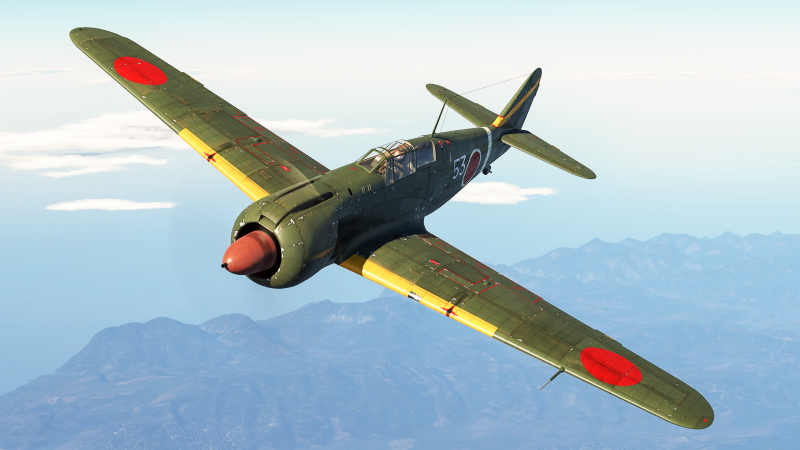Difference between revisions of "Ki-100"
m |
m (→Description) |
||
| Line 12: | Line 12: | ||
<!-- ''In the description, the first part should be about the history of and the creation and combat usage of the aircraft, as well as its key features. In the second part, tell the reader about the aircraft in the game. Insert a screenshot of the vehicle, so that if the novice player does not remember the vehicle by name, he will immediately understand what kind of vehicle the article is talking about.'' --> | <!-- ''In the description, the first part should be about the history of and the creation and combat usage of the aircraft, as well as its key features. In the second part, tell the reader about the aircraft in the game. Insert a screenshot of the vehicle, so that if the novice player does not remember the vehicle by name, he will immediately understand what kind of vehicle the article is talking about.'' --> | ||
The '''{{Specs|name}}''' is a rank {{Specs|rank}} Japanese fighter {{Battle-rating}}. It was introduced in [[Update 1.61 "Road to Glory"]]. Based on the [[Ki-61-II_Otsu_Kai|Ki-61-II]], the Ki-100 features a new Ha-112-2 radial engine that allows a faster rate-of-climb, allowing the Japanese to contest Allied bombing raids on their home islands in 1945. | The '''{{Specs|name}}''' is a rank {{Specs|rank}} Japanese fighter {{Battle-rating}}. It was introduced in [[Update 1.61 "Road to Glory"]]. Based on the [[Ki-61-II_Otsu_Kai|Ki-61-II]], the Ki-100 features a new Ha-112-2 radial engine that allows a faster rate-of-climb, allowing the Japanese to contest Allied bombing raids on their home islands in 1945. | ||
| + | |||
| + | The default camo bears the insignia of the 59th Sentai, formed in 1938, it participated in key operations during the Sino-Japanese War and Pacific Theatre. After being stationed in Java, they defended Palembang and attacked Port Darwin before moving to New Guinea, where they faced difficulties against the P-38 in the Ki-43-II. Following heavy losses and the death of Captain Shigeo Nangō in 1944, the unit returned to Japan, reequipped with the Ki-61 "Hien" and took up air defence duties in Northern Kyushu. By late 1944, they formed a kamikaze unit, stationed part of their force on Jeju Island, and continued air defence and kamikaze escort missions from Chiran. Later, in 1945 they transitioned to the Ki-100 and defended Northern Kyushu until the end of the war. | ||
In the game, the Ki-100 continues to exhibit the Ki-61's relatively balanced characteristics in speed, dive performance, climb rate, manoeuvrability, and armaments. While not particularly excelling in any trait, it does allow the player more options to contest the airspace. | In the game, the Ki-100 continues to exhibit the Ki-61's relatively balanced characteristics in speed, dive performance, climb rate, manoeuvrability, and armaments. While not particularly excelling in any trait, it does allow the player more options to contest the airspace. | ||
Latest revision as of 04:08, 9 September 2024
| This page is about the Japanese fighter Ki-100. For other versions, see Ki-61 (Family). |
Contents
Description
The Ki-100 is a rank III Japanese fighter with a battle rating of 4.7 (AB), 4.0 (RB), and 3.7 (SB). It was introduced in Update 1.61 "Road to Glory". Based on the Ki-61-II, the Ki-100 features a new Ha-112-2 radial engine that allows a faster rate-of-climb, allowing the Japanese to contest Allied bombing raids on their home islands in 1945.
The default camo bears the insignia of the 59th Sentai, formed in 1938, it participated in key operations during the Sino-Japanese War and Pacific Theatre. After being stationed in Java, they defended Palembang and attacked Port Darwin before moving to New Guinea, where they faced difficulties against the P-38 in the Ki-43-II. Following heavy losses and the death of Captain Shigeo Nangō in 1944, the unit returned to Japan, reequipped with the Ki-61 "Hien" and took up air defence duties in Northern Kyushu. By late 1944, they formed a kamikaze unit, stationed part of their force on Jeju Island, and continued air defence and kamikaze escort missions from Chiran. Later, in 1945 they transitioned to the Ki-100 and defended Northern Kyushu until the end of the war.
In the game, the Ki-100 continues to exhibit the Ki-61's relatively balanced characteristics in speed, dive performance, climb rate, manoeuvrability, and armaments. While not particularly excelling in any trait, it does allow the player more options to contest the airspace.
General info
Flight performance
| Characteristics | Max Speed (km/h at 6,000 m) |
Max altitude (metres) |
Turn time (seconds) |
Rate of climb (metres/second) |
Take-off run (metres) | |||
|---|---|---|---|---|---|---|---|---|
| AB | RB | AB | RB | AB | RB | |||
| Stock | 556 | 541 | 10000 | 20.8 | 21.7 | 10.1 | 10.1 | 350 |
| Upgraded | 605 | 580 | 19.5 | 20.0 | 18.8 | 13.8 | ||
Details
| Features | ||||
|---|---|---|---|---|
| Combat flaps | Take-off flaps | Landing flaps | Air brakes | Arrestor gear |
| ✓ | ✓ | ✓ | X | X |
| Limits | ||||||
|---|---|---|---|---|---|---|
| Wings (km/h) | Gear (km/h) | Flaps (km/h) | Max Static G | |||
| Combat | Take-off | Landing | + | - | ||
| 850 | 250 | 292 | 282 | 230 | ~15 | ~7 |
| Optimal velocities (km/h) | |||
|---|---|---|---|
| Ailerons | Rudder | Elevators | Radiator |
| < 370 | < 350 | < 410 | > 330 |
Survivability and armour
- 13 mm steel plate behind the pilot seat and headrest.
- Fuel tanks are self-sealing.
Modifications and economy
Armaments
Offensive armament
The Ki-100 is armed with:
- 2 x 20 mm Ho-5 cannons, nose-mounted (200 rpg = 400 total)
- 2 x 12.7 mm Ho-103 machine guns, wing-mounted (250 rpg = 500 total)
Suspended armament
The Ki-100 can be outfitted with the following ordnance:
- Without load
- 2 x 50 kg Army Type 94 GPHE bombs (100 kg total)
- 2 x 100 kg Army Type 94 GPHE bombs (200 kg total)
- 2 x 250 kg Army Type 92 GPHE bombs (500 kg total)
Usage in battles
This aircraft offers balanced performance characteristics that allow the pilot to choose how one wishes to fight in the Ki-100 and adapt to the combat situation as necessary. The performance of the Ki-100 is characterised by decent climb rate and manoeuvrability. The aircraft has good (but not the best) acceleration in a dive that makes it suitable for short range "boom and zoom" style attacks. The pilot should position the fighter around 1,000 m above a selected target, dive rapidly, fire a quick burst, and then pull away in a shallow climb to hold the plane's speed and escape. This is the safest way to conduct combat in the Ki-100, but there are other options available.
Against less manoeuvrable opponents, turn fighting can be a valid approach. Most German and American aircraft will not be able to out-turn you. However, turning combat is only advised when there are no other enemies around that could pounce on you while you are focused on your target. Do not manoeuvre for too long and avoid getting too slow, because your control surfaces will become less responsive. Then you will be a sitting duck for most other fighters.
With sufficient speed, the Ki-100 also has suitable energy retention characteristics for spiral climbs and other moves that can drain your opponent's energy. However, there are other fighters which are still superior in this regard.
Interceptors/Air defence: In higher altitudes you should be aware of this types of airplanes. They have good climb rate and speed but they are not very nimble. They will most likely try to head-on you and then run away. You can use nimble characteristics of your airplane to avoid this kind of attack. Most of them will not try to turn fight with you and you cant compete with your performance.
Bombers: You should avoid this kind of airplanes in higher altitudes or at least not engage them alone at start of match. Your low velocity cannons are not good enough for long range approach and going closer to them is dangerous gamble as Ki-100 is very fragile and vulnerable to fires.
Fighters: Thanks to your climb rate you will most of the time end up above them. That gives you very good opportunity for BnZ tactics. You should look after fighter that end up separated or those who are too focused chasing some of your teammates. This airplane also allow you to dogfight some of them but you should not end up in dogfight with lots of enemies since even small dose of fire can noticeably damage you. Low velocity armament also need skilled pilot against nimble opponents or in dogfights.
Manual Engine Control
| MEC elements | ||||||
|---|---|---|---|---|---|---|
| Mixer | Pitch | Radiator | Supercharger | Turbocharger | ||
| Oil | Water | Type | ||||
| Not controllable | Controllable Not auto controlled |
Controllable Not auto controlled |
Controllable Not auto controlled |
Separate | Controllable 2 gears |
Not controllable |
Pros and cons
Pros:
- Nose-mounted 20 mm Ho-5 cannons give you a better chance in head-ons
- Flexible fighting style, from turnfighting to boom-and-zoom
- Good climb rate
- Can outmanoeuvre most planes at its BR
Cons:
- Low-velocity 20 mm Ho-5 cannons are ineffective in long-range engagements
- Poor survivability
History
The Ki-100 was an fighter/interceptor which was developed from the Ki-61-II and the result of Japan's need to stop American bombing raids over the mainland. In October of 1944, the decision was made to fit 3 Ki-61s with Ha-112 radial engines, which were lighter and more reliable than the Ha-140 inline engine that the Ki-61 used. On February 1, 1945, the modified Ki-61 made its first flight, where it performed well. Continued testing throughout March and April proved that it outperformed the Ki-84, then considered the best fighter in the IJAAS's operation. In March 1945, because of its favourable performance, coupled with its much more reliable engine, it was ordered into production and given the Ki-100 designation. It began combat service on March 9, and was used mainly for its intended purpose until the Japanese surrender in 1945. A total of 396 were built.
Media
- Skins
- Videos
See also
Links to the articles on the War Thunder Wiki that you think will be useful for the reader, for example:
- reference to the series of the aircraft;
- links to approximate analogues of other nations and research trees.
External links
| Kawasaki Aircraft Industries (川崎航空機工業株式会社) | |
|---|---|
| Biplane Fighters | Ki-10-I · Ki-10-I C · Ki-10-II · Ki-10-II C |
| Fighters | Ki-61-I ko · Ki-61-I otsu · Ki-61-I hei · Tada's Ki-61-I hei · Ki-61-I tei · Ki-61-II Otsu Kai |
| Ki-100 · Ki-100-II | |
| Interceptors | Ki-45 ko · Ki-45 otsu · Ki-45 hei · Ki-45 tei |
| Ki-96 | |
| Ki-102 otsu | |
| Ki-108 Kai | |
| Bombers | Ki-32 |
| Ki-48-II otsu | |
| Captured | ␗Ki-45 hei/tei · ␗Ki-61-I otsu · ▃Ki-61-Ib |
| See also | Kawasaki Shipyard Co. |
| Japan fighters | |
|---|---|
| Navy | |
| Carrier-based fighter | |
| A5M | A5M4 · Hagiri's A5M4 |
| A6M | A6M2 mod. 11 · A6M2 · A6M3 · A6M3 mod. 22 · A6M3 mod. 22Ko · A6M5 · A6M5 Ko · A6M5 otsu · A6M5 Hei · A6M6c |
| A7He | A7He1* |
| A7M | A7M1 (NK9H) · A7M2 |
| Land-based Fighter | |
| J2M | J2M2 · J2M3 · J2M4 Kai · J2M5 · J2M5 (30 mm) |
| J6K | J6K1 |
| J7W | J7W1 |
| N1K-J | N1K1-Ja · N1K2-J · N1K2-Ja |
| Fighter seaplane | |
| N1K | N1K1 |
| A6M-N | A6M2-N |
| Army | |
| Ki-10 | Ki-10-I · Ki-10-I C · Ki-10-II · Ki-10-II C |
| Ki-27 | Ki-27 otsu · Ki-27 otsu Tachiarai |
| Ki-43 | Ki-43-I · Ki-43-II · Ki-43-III otsu |
| Ki-44 | Ki-44-I · Ki-44-I 34 · Ki-44-II otsu · Ki-44-II hei |
| Ki-61 | Ki-61-I ko · Ki-61-I otsu · Ki-61-I hei · Tada's Ki-61-I hei · Ki-61-I tei · Ki-61-II Otsu Kai |
| Ki-84 | Ki-84 ko · Ki-84 otsu · Ki-84 hei |
| Ki-87 | Ki-87 |
| Ki-94 | Ki-94-II |
| Ki-100 | Ki-100 · Ki-100-II |
| Other countries | ▅F4U-1A · ▅P-51C-11-NT · ▅Bf 109 E-7 · ▅Fw 190 A-5 |
| *Imported designation of the He 112 (A6M was in development - A7M would take A7 designation after the cancelation of the A7He) | |






